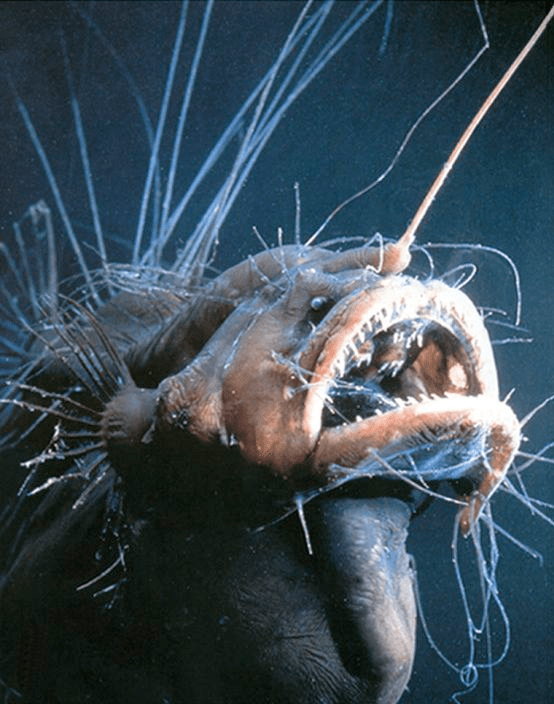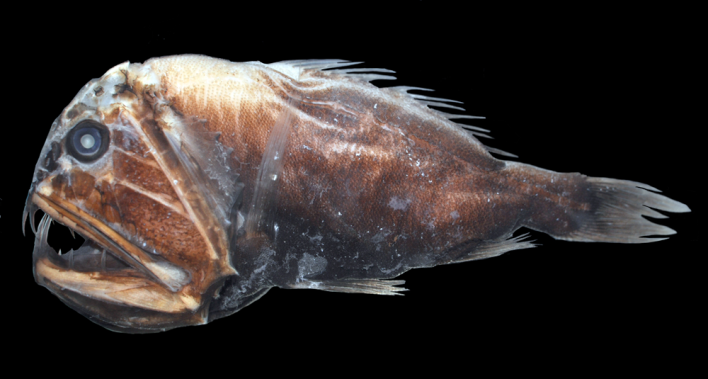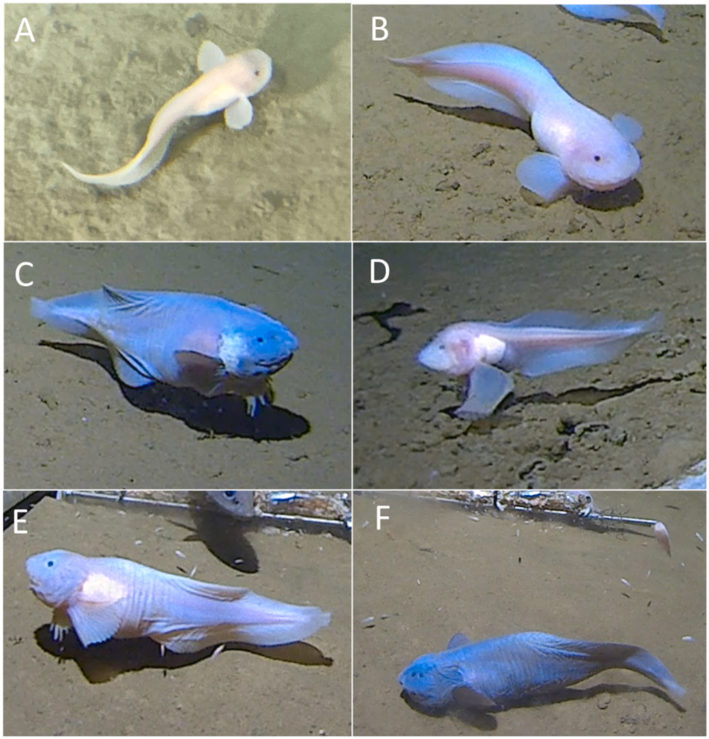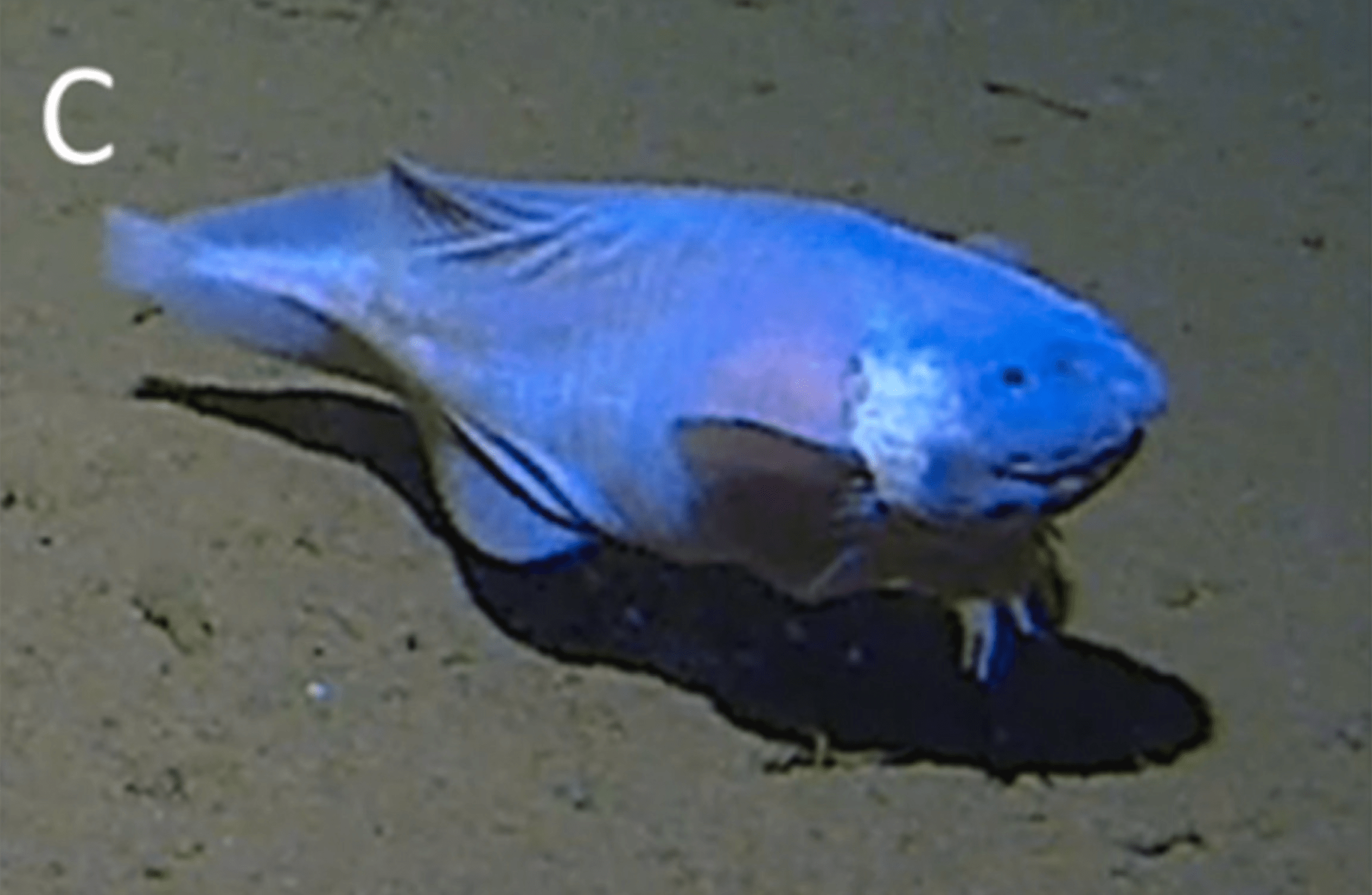The Russian fisherman Roman Fedortsov has built an online following by posting close-ups of deep-sea creatures caught in fishing trawls, whose bodies have often been mangled by the sharp change in pressure and temperature at the surface. Their eyes bulge out of their faces; their skin sags like slime. They are scary and gross, which makes sense, scientifically speaking. The freezing temperatures, crushing pressures, and unrelenting darkness of the deep sea render their ecosystem very unlike our own. So we should expect that fish adapted to that extreme habitat look so strange, weirdly shaped, and loathsome when viewed in the light of this one. While many nature-related accounts inspire wonder, Fedortsov's never-ending stream of horrible fish inspires revulsion.
But in recent years, as deep-sea technology advances and scientists set out more baited traps to attract fish from the deepest swaths of the sea, I've developed an unshakeable and only quasi-vibe-based theory of the aesthetics of deep-sea fish, which is this: The deeper you go, the cuter the fish.
Let me explain. The deep sea officially starts where sunlight dwindles, at around depths of 200 meters. This region is called the twilight zone, and the minuscule amount of light that trickles down here is too scarce for photosynthesis. The midnight zone begins below 1,000 meters, depths totally devoid of sunlight. The abyssopelagic zone, or, more casually, the abyss, begins at 4,000 meters, followed by the hadal zone at depths of 6,000 meters and deeper. The absolute deepest part of the ocean is the Challenger Deep, located in the southern end of the Mariana Trench, which plunges to about 10,395 meters. This is about 35,876 feet deep, deeper than an upside-down Mount Everest plus a 7,000-foot carrot (a 7,000-foot anything, but I think a giant carrot is a fun visualization).

The quintessentially scary fish we often associate with the deep ocean, such as anglerfish with candle-like lures, sword-shaped viperfish, or the menacingly snouted goblin shark, all live in the twilight zone. And most anglerfish, the unofficial ambassadors of the deep, are simply not that big. While an Atlantic bluefin tuna can grow up to 13 feet long and weigh 2,000 pounds, the largest female anglerfish can grow about three feet long. Most species never even reach a foot long, and the males are smaller than cashews. And some anglerfish are even somewhat cute, such as the sea toad, which resembles a red handball with foot-like fins. Most of these rather menacing-looking fish don't get much deeper than the twilight zone, which is the shallow end of the pool, relatively speaking.
There are some strange-looking stragglers that slink deeper into the abyss. The black swallower, a fish that can swallow things larger than itself—even though this act looks highly uncomfortable—is found past 2,700 meters. The deep-sea lizardfish, which is fairly regular-looking, and the flabby whalefish, which looks more cool than scary, both reach depths of 3,500 meters. The fangtooth, a classic deep-sea creeper, can live anywhere from 500 to 5,000 meters. But this is still the abyss and not the deepest sea, which is where my theory comes into play.

Most of the ocean floor bottoms out at around 4,000 to 6,000 meters. But the absolute deepest sea exists in the hadal zone, which occurs only in trenches, those steep, narrow submarine canyons created where tectonic plates slide over each other. Here, observations of fish are much scarcer. The first fish collected from depths greater than 6,000 meters was the cusk eel Holcomycteronus profundissimus, which was trawled by the 1901 Princess Alice expedition. The cusk eel is not a cute fish, but it is also not a scary one; having forgone any of the spooky lures, gaping jaws, and tripod legs of the twilight denizens, the cusk eel has a pleasantly smooth and tapering body that hints at the real cuties lurking even deeper. Because the hadal zone is overwhelmingly ruled by one family of fish: Liparidae, or the snailfishes.
Snailfish are a sprawling family of bony fish that live at nearly every possible depth, from shallow waters to the current record of 8,336 meters deep. All snailfish have a simple body plan, resembling tadpoles or teardrops. Their tails are incredibly tiny, and they have no scales. Some snailfish have beautiful patterns, like this blotched snailfish, and others are loaded with antifreeze, like the variegated snailfish. But the snailfishes in the hadal zone all look quite similar. They have soft, pastel bodies cushioned with a translucent layer of gel, which means the sheen of their liver shines through their skin. They have small black eyes. They are, unscientifically speaking, baby.
is there a name for this#mossworm pic.twitter.com/AexE4LFEGq
— Mossworm (@Mossworm1) July 10, 2023
Unlike lone cusk eels or grenadier fish that can trespass down from the abyss, snailfishes form large, active communities in the hadal zone, according to a paper published in 2016 in the journal Deep Sea Research Part I: Oceanographic Research Papers. They are trench specialists, so adapted to the pressure of each trench that they cannot leave their trench to get to another, as marine scientist Alan Jamieson of the University of Western Australia, who is probably the world's expert on the deepest-ever fish, told Scientific American. "Each trench has its own snailfish in it," Jamieson said. Isn't that charming? They have homes!
In 2014, Jamieson and colleagues caught the world's deepest fish at the time, the Mariana snailfish, or Pseudoliparis swirei. The researchers laid camera traps baited with mackerel at the upper edges of the trench, and swarms of milky pink snailfish came to bite, Mackenzie Gerringer, a researcher at SUNY Geneseo, explained in a piece for The Conversation. Scientists have since caught 37 Mariana snailfish from depths of 6,896 and 7,966 meters, and filmed the species swimming at 8,178 meters. In the footage, a beautifully pink snailfish saunters up to the bait. You can't tell me this isn't one of the cutest fish you've ever seen!
In April, Jamieson and colleagues filmed an even deeper—and dare I say, even cuter—snailfish in the Izu-Ogasawara Trench south of Japan, at a depth of 8,336 meters. This snailfish was quite literally baby, a juvenile that was about as long as a lime. In a paper published this month in the journal Deep Sea Research Part I: Oceanographic Research Papers, the researchers describe this new, deepest-ever snailfish and other snailfishes they observed in trenches around Japan. Along with notes on these discoveries, the paper contained a grid of snailfish that could only be described as immaculate—fish that are not just some of the deepest fish ever, but also the cutest.
I present them now, for your consideration. Snailfish A, an unknown and pearly white species filmed in the Ryuku trench as low as 7,339 meters. Snailfish B, a species called Pseudoliparis belyaevi who may be even more adorable, was found as deep as 8,022 meters and appeared to be the most common species found in the Japan Trench. Snailfish C, a beautiful opaque blue and the chunkiest snailfish yet, representing another unknown species filmed at depths as low as 7,001 meters. As befits its heft, Snailfish C was also described as "more sluggish" in its swimming than Snailfish B. Snailfish D, found as low as 8,022 meters, is certainly less chunky but has enchantingly big, Dumbo-like pectoral fins. Snailfish E, at 8,336 meters deep, is the dimpled baby mentioned above. And the beautiful blue Snailfish F, last but certainly not least, was found wiggling around the Izu-Ogasawara Trench as low as 7,050 meters. To determine the cutest among these snailfish is a subjective task. (But in my personal ranking, Snailfish C takes the cake.)

While the Japan Trench peters out at 8,020 meters, the Izu-Ogasawara Trench continues to 9,780 meters, and the Mariana famously plunges to 11,000 meters. Could there be an even more heart-palpitatingly adorable snailfish lurking, yet to be discovered, in these most impossible depths?
Probably not. Although sea cucumbers, crustaceans, and anemones dwell in the deepest 25 percent of the ocean, below 8,400 meters, no one has ever glimpsed a fish at these depths. A group of researchers suggested fish might be biochemically limited from inhabiting such extreme depths. Deep-sea fish have adapted to live under immense hydrostatic pressure with the assistance of molecules called trimethyl-amine oxide (TMAO), which stabilizes their proteins. While hydrostatic pressure compresses the fish from all directions, TMAO prevents water from being pushed into the interior of cells to allow them to keep functioning. At a certain depth, the fish would need so much TMAO to combat the effects of the pressure that the concentration in their cells would be higher than sea water. This would cause water to flow back into the cell due to osmosis, forcing the fish to keep pumping water out of their cells to keep them from rupturing. When the researchers laid out baited camera traps at the deepest depths of the Mariana Trench, around 11,000 meters, only clouds of tiny crustaceans called amphipods showed up to feast, as expected.
But there is one deeply mysterious snailfish that has only been briefly filmed but never captured, a snailfish that may never outrank Snailfish C in cuteness, but, may, upon closer inspection, turn out to be the most beautiful fish in the whole ocean. It is called the Ethereal snailfish and, like its name suggests, it is downright celestial. This type of snailfish was first filmed serendipitously at 7,939 meters in the Mariana Trench. The scientists on the cruise dubbed it the Ethereal snailfish for its "delicate morphology and graceful swimming gait," according to the 2016 paper in Deep Sea Research Part I: Oceanographic Research Papers. The Ethereal snailfish is not a species but a morphotype, an an exceptionally fragile form of snailfish that has been recorded in several trenches, including the Mariana, Atacama, and Japan trenches (it appears as Snailfish D in the grid above). You can see the Ethereal snailfish swimming, quite ethereally, past a swarm of amphipods in the video below.
Is the Ethereal snailfish indeed too perfect for this mortal world? Perhaps this is not a question for science, but a question for the heart. Its billowing pectoral fins look like the wings of the hottest angel or the arms of the friendliest ghost. So no, I do not know if the Ethereal snailfish is the cutest fish in the whole ocean. But if there is any fish that looks like a fish we mortals were never meant to encounter, it is a fish that resembles the single teardrop of some unknowable God, the living equivalent of a newborn star, or some sublime Haribo gummy that transforms the eater into a beam of light. This must be why the Ethereal snailfish dwells in the furthest reaches of the deepest ocean. But until scientists capture the face of the Ethereal snailfish in high resolution, we can gaze again upon the visage of Snailfish C.







